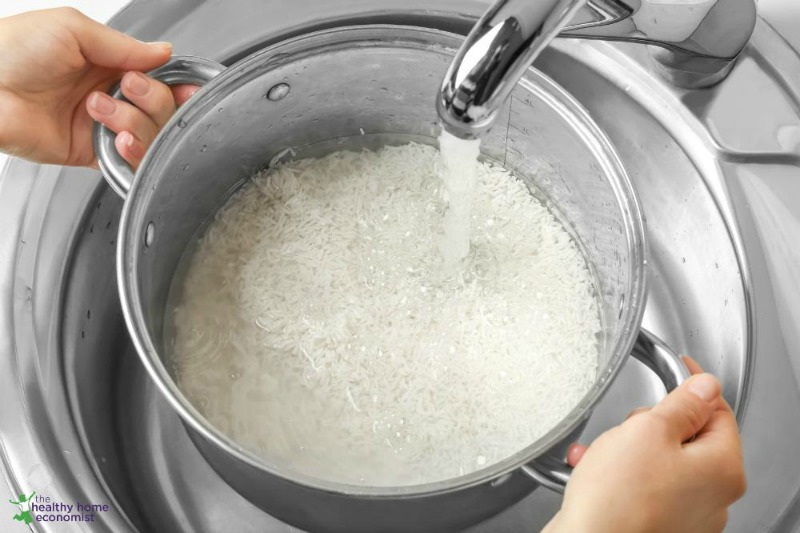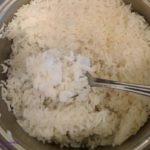Table of Contents[Hide][Show]

Many people I know who follow ancestrally inspired diets assume that soaking white rice before cooking is not necessary. This is because white rice is milled, meaning the husk, bran, and germ have been removed.
While this process removes much of the nutrition, it also renders the rice much more digestible for some people. Some experts go so far as to suggest that white rice is healthier than brown, especially when it comes to maintaining dental and intestinal health.
With primarily just the starch remaining, phytates, lectins and other anti-nutrients present in the hulls are also largely removed.
Hence the very solid reasoning for not soaking it.
Soaking is Not Just for Phytic Acid
I would generally agree with the assessment that within the context of normal, moderate consumption, soaking white rice is not necessary.
But we no longer live in “normal” times when it comes to crop cultivation. Let me explain …
In my early days of traditional cooking, I rarely if ever soaked white rice because our family ate it infrequently. It was mostly starch anyway, right?
However, in recent years, I have taken great care to rinse and soak my white rice before cooking. My reasons have nothing to do with eliminating anti-nutrients.
Nowadays, I soak milled white rice to eliminate toxins most specifically arsenic.
You may already know that arsenic contamination in rice crops is a worldwide problem. This is true even in organically tended rice paddies. This article on arsenic contamination in rice crops outlines the serious situation in detail.
Rice loves arsenic. If there is any present in the soil or water where it is cultivated (arsenic is highly water-soluble), rice crops take it in at a rate ten times higher than other plants! The fact that rice grows in flooded paddies makes the potential exposure to this heavy metal even worse.
Is it any wonder that products made with rice, even organic baby formulas, are testing high in arsenic? The reason is the inclusion of rice syrup as a major ingredient.
The good news is that soaking milled rice in six parts water to one part rice, discarding the soaking liquid, rinsing the rice thoroughly, and then cooking in fresh water significantly reduces arsenic levels by up to 80%. More research is needed, however, to identify how easily different rice varieties give up their arsenic. (1)
Cooking White Rice After Soaking
If you’ve now realized that soaked white rice is the way to go given the global problem of arsenic contamination, the next question is – how to do it?
The book Nourishing Traditions only covers soaking brown rice. My video on soaking grains filmed for the Weston A. Price Foundation only covers brown rice as well.
Warning: if you try to soak white rice first and cook it according to the package directions, it will turn out mushy. I tell you this from experience!
With that, let me share with you my personal recipe for soaking and then cooking up a perfect pot of white rice every time! Tip: this method also works well if you use store-bought or homemade bone broth to cook it instead of filtered water.
The rule of thumb is to reduce the cooking liquid by 1/6 if the white rice has been soaked. For example, if the package instructions say to use 3 cups of water to cook 2 cups of rice, then reduce the water to 2.5 cups. This roughly compensates for the amount of water taken in by the rice as it soaks.

Soaking and Cooking White Rice Recipe
How to soak and cook white rice so that it turns out light and fluffy every time. Recipe uses some bone broth to enhance nutritional profile and flavor considerably.
Ingredients
- 2 cups white rice basmatic rice is recommended
- 13.5 cups filtered water
- 1 cup bone broth
- 2 Tbl butter
Instructions
-
Rinse white rice and place in a large pot. Add 12 cups of filtered water.
-
Stir until the rice is completely wet and settles to the bottom of the pot. Cover and leave on the counter for 4-6 hours or overnight.
-
Drain rice thoroughly in large strainer. Rinse one more time.
-
Rinse soaking pot with clean filtered water and put soaked rice back in.
-
Add 1.5 cups fresh filtered water , 1 cup of bone broth, and butter. Stir.
-
Bring uncovered pot to a boil. Stir once or twice, reduce heat to medium/low and cover.
-
Cook for 13 minutes. Crack lid and see if all the water has been absorbed. If not, replace cover and cook for an additional 2-3 minutes or until remaining water is absorbed.
-
Remove from heat, leaving the lid on. Let sit on the counter for 10 minutes to steam.
-
Remove lid and fluff with a fork. Serve.
-
Refrigerate leftovers once the rice is fully cooled to room temperature.
Recipe Notes
I love serving classic beef stew over soaked white basmati rice.








Mexican rice is cooked by browning the white rice in oil first before adding broth and seasonings. If I soak the rice first should I let it dry before making Mexican rice? Thank you!
That is a good question! That is the only way to go it seems, since the oil won’t adhere to wet rice.
My grandmother was born and grew up in Southern Louisiana in the early 1900’s. She taught my mother to wash rice in a strainer under running water and rub it with your hands while doing so. At least 3 to 5 times She never soaked the rice. Use fresh water for cooking. All she ever used was a pat of butter and a pinch of salt. Grandma said that the salt keeps the rice from sticking. LoL, my rice always sticks. Her rice was always fluffy and did not stick.
I don’t think soaking white rice is traditional as you pointed out. However, I think it is a good idea today with the arsenic issues cropping up even in organic rice crops.
Rice and grains tend to just gunk up in my lymph and joints. Starches, in general are good for making sick,… especially as I’ve gotten older. So, in order for me to thrive like I’m still in my teens/twenties (I’m 50),… I mainly stick to fruit, greens (not amaranthaceae though), animal products, and beer. So, I only minimally consume grains (other than beer), and typically that might be regular-real plain-salted oatmeal cooked in water. Maybe a few or several times per year.
Key thing on health is consuming what your body can handle well,… and which your lymph and joints keep you well informed as to what is good and what isn’t for you. Know your lymph and joints,… and your dental health as well. Those are the three key points of indication: lymph, dental, and joints,…. oh,… and skin,…. 4 key indicators of ones body: lymph, dental, skin, and joints,…. and sexual vitality,… so, make that five key points,… and they all work together.
Sorry for the stream of consciousness writing,…. but, there you go,… your keys to the kingdom of health,… as you practically can, if you can.
Amazing and inviting.
Thank you
Somewhere I recently came across the information that WASHING rice is extremely important – because it has talc on it. While it was not stated, I came away with the notion that it is added to the rice so it doesn’t clump in the packaging. This explains why Japanese relatives so carefully wash their rice in 3 or 4 changes of water, rubbing the grains by the handful in the water.
Yes, the talc issue is discussed in the linked article above about arsenic in rice. If you soak it though and then rinse before cooking, that is essentially accomplishing the same thing.
Hi.. I read somewhere that washing rice multiple times removes all B-vitamins from it.. In that case, aren’t all the B-vitamins lost on soaking rice and draining away the water?
Most of the B vitamins are already lost polishing brown rice into white rice.
Any suggestions for vegan folks please? (No bone broth & no butter).
There are no vegan alternatives to bone broth. Vegetable broth doesn’t have the same health benefits. You can substitute coconut oil for the butter, but the rice doesn’t taste nearly as good IMO.
I use Miyoko’s Organic Vegan Butter and my own vegetable/mushroom stock. I refuse to eat any animal product and do not seem to be suffering from not including bone broth in my WFPB diet.
Sarah, hi, is it ok to use an instapot for cooking in, after soaking the rice.
Thanks
Yes, an instapot pressure cooker for cooking rice post soaking would be fine. I don’t know what the adjustment for the amount of water would be though .. I don’t have one to have tested it.
Thank you, Sarah. Great info. Do you know how much of the carbs are removed by soaking and fermenting rice and other grains, or are they just as high?
Very little of the carbs in white rice are affected by soaking.
Seriously, given that white rice has no nutritional value and requires this insane level of preparation just to make it safe to eat, why would I want to bother with it at all? I’ll just make “rice” from cauliflower!